| Wheat | |
|---|---|
 | |
| Scientific classification | |
| Kingdom: | Plantae |
| (unranked): | Angiosperms |
| (unranked): | Monocots |
| (unranked): | Commelinids |
| Order: | Poales |
| Family: | Poaceae |
| Subfamily: | Pooideae |
| Tribe: | Triticeae |
| Genus: | Triticum L. |
| Species | |
| T. aestivum References:T. aethiopicum T. araraticum T. boeoticum T. carthlicum T. compactum T. dicoccoides T. dicoccum T. durum T. ispahanicum T. karamyschevii T. macha T. militinae T. monococcum T. polonicum T. spelta T. sphaerococcum T. timopheevii T. turanicum T. turgidum T. urartu T. vavilovii T. zhukovskyi Serial No. 42236 ITIS 2002-09-22 | |
Wheat was a key factor enabling the emergence of city-based societies at the start of civilization because it was one of the first crops that could be easily cultivated on a large scale, and had the additional advantage of yielding a harvest that provides long-term storage of food. Wheat is a factor in contributing to city-states in the Fertile Crescent including the Babylonian and Assyrian empires. Wheat grain is a staple food used to make flour for leavened, flat and steamed breads, biscuits, cookies, cakes, breakfast cereal, pasta, noodles, couscous[3] and for fermentation to make beer,[4] other alcoholic beverages,[5] or biofuel.[6]
Wheat is planted to a limited extent as a forage crop for livestock, and its straw can be used as a construction material for roofing thatch.[7][8] The husk of the grain, separated when milling white flour, is bran. Wheat germ is the embryo portion of the wheat kernel. It is a concentrated source of vitamins, minerals, and protein, and is sustained by the larger, starch storage region of the kernel—the endosperm.
Contents
|
History
Wheat is one of the first cereals known to have been domesticated, and wheat's ability to self-pollinate greatly facilitated the selection of many distinct domesticated varieties. The archaeological record suggests that this first occurred in the regions known as the Fertile Crescent, and the Nile Delta. These include southeastern parts of Turkey, Syria, the Levant, Israel, and Egypt. Recent findings narrow the first domestication of wheat down to a small region of southeastern Turkey,[9] and domesticated Einkorn wheat at Nevalı Çori—40 miles (64 km) northwest of Gobekli Tepe in Turkey—has been dated to 9,000 B.C.[10] However evidence for the exploitation of wild barley has been dated to 23,000 B.C. and some say this is also true of pre-domesticated wheat.[11]Origin
Genetic analysis of wild einkorn wheat suggests that it was first grown in the Karacadag Mountains in southeastern Turkey. Dated archeological remains of einkorn wheat in settlement sites near this region, including those at Abu Hureyra in Syria, confirms the domestication of einkorn near the Karacadag Mountain Range. The earliest carbon-14 date for the einkorn wheat remains at Abu Hureyra is 7800 to 7500 years BCE.[12] Recent genetic and archeological discoveries indicate that both emmer wheat and durum (hard pasta wheat) also originated from this same Karacadag region of southeastern Turkey. Remains of harvested emmer from several sites near the Karacadag Range have been dated to between 8800 and 8400 BCE, that is, in the Neolithic period.[13]Cultivation and repeated harvesting and sowing of the grains of wild grasses led to the creation of domestic strains, as mutant forms ('sports') of wheat were preferentially chosen by farmers. In domesticated wheat, grains are larger, and the seeds (spikelets) remain attached to the ear by a toughened rachis during harvesting. In wild strains, a more fragile rachis allows the ear to easily shatter and disperse the spikelets.[14] Selection for these traits by farmers might not have been deliberately intended, but simply have occurred because these traits made gathering the seeds easier; nevertheless such 'incidental' selection was an important part of crop domestication. As the traits that improve wheat as a food source also involve the loss of the plant's natural seed dispersal mechanisms, highly domesticated strains of wheat cannot survive in the wild.
Cultivation of wheat began to spread beyond the Fertile Crescent after about 8000 BCE. Jared Diamond traces the spread of cultivated emmer wheat starting in the Fertile Crescent about 8500 BCE, reaching Greece, Cyprus and India by 6500 BCE, Egypt shortly after 6000 BCE, and Germany and Spain by 5000 BCE.[15] "The early Egyptians were developers of bread and the use of the oven and developed baking into one of the first large-scale food production industries." [16] By 3000 BCE, wheat had reached England, and Scandinavia. A millennium later it reached China.
Wheat spread through out Europe and in England, thatch was used for roofing in the bronze age, and was in common use until the late 19th century.[17]
Farming techniques
Technological advances in soil preparation and seed placement at planting time, use of crop rotation and fertilizers to improve plant growth, and advances in harvesting methods have all combined to promote wheat as a viable crop. Agricultural cultivation using horse collar leveraged plows (at about 3000 BCE) was one of the first innovations that increased productivity. Much later, when the use of seed drills replaced broadcasting sowing of seed in the 18th century, another great increase in productivity occurred. Yields of wheat per unit area increased as methods of crop rotation were applied to long cultivated land, and the use of fertilizers became widespread. Improved agricultural husbandry has more recently included threshing machines and reaping machines (the 'combine harvester'), tractor-drawn cultivators and planters, and better varieties (see Green Revolution and Norin 10 wheat). Great expansions of wheat production occurred as new arable land was farmed in the Americas and Australia in the 19th and 20th centuries.Genetics
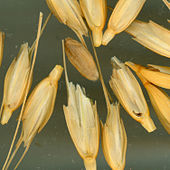
Spikelets of a hulled wheat, einkorn
- Einkorn wheat (T. monococcum) is diploid (AA, two complements of seven chromosomes, 2n=14).[1]
- Most tetraploid wheats (e.g. emmer and durum wheat) are derived from wild emmer, T. dicoccoides. Wild emmer is itself the result of a hybridization between two diploid wild grasses, T. urartu and a wild goatgrass such as Aegilops searsii or Ae. speltoides. The unknown grass has never been identified among now surviving wild grasses, but the closest living relative is Aegilops speltoides.[citation needed] The hybridization that formed wild emmer (AABB) occurred in the wild, long before domestication,[18] and was driven by natural selection.
- Hexaploid wheats evolved in farmers' fields. Either domesticated emmer or durum wheat hybridized with yet another wild diploid grass (Aegilops cylindrica) to make the hexaploid wheats, spelt wheat and bread wheat.[18] These have three sets of paired chromosomes, three times as many as in diploid wheat.
Wild grasses in the genus Triticum and related genera, and grasses such as rye have been a source of many disease-resistance traits for cultivated wheat breeding since the 1930s.[19]
Heterosis, or hybrid vigor (as in the familiar F1 hybrids of maize), occurs in common (hexaploid) wheat, but it is difficult to produce seed of hybrid cultivars on a commercial scale (as is done with maize) because wheat flowers are complete and normally self-pollinate. Commercial hybrid wheat seed has been produced using chemical hybridizing agents; these chemicals selectively interfere with pollen development, or naturally occurring cytoplasmic male sterility systems. Hybrid wheat has been a limited commercial success in Europe (particularly France), the USA and South Africa.[20] F1 hybrid wheat cultivars should not be confused with the standard method of breeding inbred wheat cultivars by crossing two lines using hand emasculation, then selfing or inbreeding the progeny many (ten or more) generations before release selections are identified to be released as a variety or cultivar.
Synthetic hexaploids made by crossing the wild goatgrass wheat ancestor Aegilops tauschii and various durum wheats are now being deployed, and these increase the genetic diversity of cultivated wheats.
Stomata (or leaf pores) are involved in both uptake of carbon dioxide gas from the atmosphere and water vapor losses from the leaf due to water transpiration. Basic physiological investigation of these gas exchange processes has yielded valuable carbon isotope based methods that are used for breeding wheat varieties with improved water-use efficiency. These varieties can improve crop productivity in rain-fed dry-land wheat farms.[21]
In 2010, a team of scientists announced they had decoded the wheat genome for the first time (95% of the genome of a variety of wheat known as Chinese Spring line 42).[22] This announcement was widely misreported as representing a finished genome sequence. In fact, sequence data was produced which allows the identification of wheat genes, but the data was not assembled to represent the map of the genome. Information on current wheat genome sequencing activities can be found at http://www.wheatgenome.info/
Plant breeding
Main article: Physiological and molecular wheat breeding
In traditional agricultural systems wheat populations often consist of landraces, informal farmer-maintained populations that often maintain high levels of morphological diversity. Although landraces of wheat are no longer grown in Europe and North America, they continue to be important elsewhere. The origins of formal wheat breeding lie in the nineteenth century, when single line varieties were created through selection of seed from a single plant noted to have desired properties. Modern wheat breeding developed in the first years of the twentieth century and was closely linked to the development of Mendelian genetics. The standard method of breeding inbred wheat cultivars is by crossing two lines using hand emasculation, then selfing or inbreeding the progeny. Selections are identified (shown to have the genes responsible for the varietal differences) ten or more generations before release as a variety or cultivar.[23]F1 hybrid wheat cultivars should not be confused with wheat cultivars deriving from standard plant breeding. Heterosis or hybrid vigor (as in the familiar F1 hybrids of maize) occurs in common (hexaploid) wheat, but it is difficult to produce seed of hybrid cultivars on a commercial scale as is done with maize because wheat flowers are complete and normally self-pollinate.[23] Commercial hybrid wheat seed has been produced using chemical hybridizing agents, plant growth regulators that selectively interfere with pollen development, or naturally occurring cytoplasmic male sterility systems. Hybrid wheat has been a limited commercial success in Europe (particularly France), the United States and South Africa.[24]
The major breeding objectives include high grain yield, good quality, disease and insect resistance and tolerance to abiotic stresses include mineral, moisture and heat tolerance. The major diseases in temperate environments include the following, arranged in a rough order of their significance from cooler to warmer climates: eyespot, Stagonospora nodorum blotch (also known as glume blotch), yellow or stripe rust, powdery mildew, Septoria tritici blotch (sometimes known as leaf blotch), brown or leaf rust, Fusarium head blight, tan spot and stem rust. In tropical areas, spot blotch (also known as Helminthosporium leaf blight) is also important.
Hulled versus free-threshing wheat
The four wild species of wheat, along with the domesticated varieties einkorn,[25] emmer[26] and spelt,[27] have hulls. This more primitive morphology (in evolutionary terms) consists of toughened glumes that tightly enclose the grains, and (in domesticated wheats) a semi-brittle rachis that breaks easily on threshing. The result is that when threshed, the wheat ear breaks up into spikelets. To obtain the grain, further processing, such as milling or pounding, is needed to remove the hulls or husks. In contrast, in free-threshing (or naked) forms such as durum wheat and common wheat, the glumes are fragile and the rachis tough. On threshing, the chaff breaks up, releasing the grains. Hulled wheats are often stored as spikelets because the toughened glumes give good protection against pests of stored grain.[25]Naming
For more details on this topic, see Taxonomy of wheat.
There are many botanical classification systems used for wheat species, discussed in a separate article on Wheat taxonomy. The name of a wheat species from one information source may not be the name of a wheat species in another.Within a species, wheat cultivars are further classified by wheat breeders and farmers in terms of:
- growing season, such as winter wheat vs. spring wheat,[8] by gluten content, such as hard wheat (high protein content) vs. soft wheat (high starch content), or by grain color (red, white or amber).
- Protein content. Bread wheat protein content ranges from 10% in some soft wheats with high starch contents, to 15% in hard wheats.
- The quality of the wheat protein gluten. This protein can determine the suitability of a wheat to a particular dish. A strong and elastic gluten present in bread wheats enables dough to trap carbon dioxide during leavening, but elastic gluten interferes with the rolling of pasta into thin sheets. The gluten protein in durum wheats used for pasta is strong but not elastic.
- Grain color (red, white or amber). Many wheat varieties are reddish-brown due to phenolic compounds present in the bran layer which are transformed to pigments by browning enzymes. White wheats have a lower content of phenolics and browning enzymes, and are generally less astringent in taste than red wheats. The yellowish color of durum wheat and semolina flour made from it is due to a carotenoid pigment called lutein, which can be oxidized to a colorless form by enzymes present in the grain.
Major cultivated species of wheat
- Common wheat or Bread wheat (T. aestivum) – A hexaploid species that is the most widely cultivated in the world.
- Durum (T. durum) – The only tetraploid form of wheat widely used today, and the second most widely cultivated wheat.
- Einkorn (T. monococcum) – A diploid species with wild and cultivated variants. Domesticated at the same time as emmer wheat, but never reached the same importance.
- Emmer (T. dicoccum) – A tetraploid species, cultivated in ancient times but no longer in widespread use.
- Spelt (T. spelta) – Another hexaploid species cultivated in limited quantities.
- Durum – Very hard, translucent, light-colored grain used to make semolina flour for pasta.
- Hard Red Spring – Hard, brownish, high-protein wheat used for bread and hard baked goods. Bread Flour and high-gluten flours are commonly made from hard red spring wheat. It is primarily traded at the Minneapolis Grain Exchange.
- Hard Red Winter – Hard, brownish, mellow high-protein wheat used for bread, hard baked goods and as an adjunct in other flours to increase protein in pastry flour for pie crusts. Some brands of unbleached all-purpose flours are commonly made from hard red winter wheat alone. It is primarily traded by the Kansas City Board of Trade. One variety is known as "turkey red wheat", and was brought to Kansas by Mennonite immigrants from Russia.[28]
- Soft Red Winter – Soft, low-protein wheat used for cakes, pie crusts, biscuits, and muffins. Cake flour, pastry flour, and some self-rising flours with baking powder and salt added, for example, are made from soft red winter wheat. It is primarily traded by the Chicago Board of Trade.
- Hard White – Hard, light-colored, opaque, chalky, medium-protein wheat planted in dry, temperate areas. Used for bread and brewing.
- Soft White – Soft, light-colored, very low protein wheat grown in temperate moist areas. Used for pie crusts and pastry. Pastry flour, for example, is sometimes made from soft white winter wheat.
As a food
| Nutritional value per 100 g (3.5 oz) | |
|---|---|
| Energy | 1,506 kJ (360 kcal) |
| Carbohydrates | 51.8 g |
| Dietary fiber | 13.2 g |
| Fat | 9.72 g |
| Protein | 23.15 g |
| Thiamine (Vit. B1) | 1.882 mg (145%) |
| Riboflavin (Vit. B2) | 0.499 mg (33%) |
| Niacin (Vit. B3) | 6.813 mg (45%) |
| Pantothenic acid (B5) | 0.05 mg (1%) |
| Vitamin B6 | 1.3 mg (100%) |
| Folate (Vit. B9) | 281 μg (70%) |
| Calcium | 39 mg (4%) |
| Iron | 6.26 mg (50%) |
| Magnesium | 239 mg (65%) |
| Phosphorus | 842 mg (120%) |
| Potassium | 892 mg (19%) |
| Zinc | 12.29 mg (123%) |
| Manganese 13.301 mg | |
| Percentages are relative to US recommendations for adults. Source: USDA Nutrient database | |
Nutrition
100 grams of hard red winter wheat[clarification needed] contain about 12.6 grams of protein, 1.5 grams of total fat, 71 grams of carbohydrate (by difference), 12.2 grams of dietary fiber, and 3.2 mg of iron (17% of the daily requirement); the same weight of hard red spring wheat contains about 15.4 grams of protein, 1.9 grams of total fat, 68 grams of carbohydrate (by difference), 12.2 grams of dietary fiber, and 3.6 mg of iron (20% of the daily requirement).[29]Much of the carbohydrate fraction of wheat is starch. Wheat starch is an important commercial product of wheat, but second in economic value to wheat gluten.[30] The principal parts of wheat flour are gluten and starch. These can be separated in a kind of home experiment, by mixing flour and water to form a small ball of dough, and kneading it gently while rinsing it in a bowl of water. The starch falls out of the dough and sinks to the bottom of the bowl, leaving behind a ball of gluten.
Health concerns
Main article: Gluten sensitivity
Roughly 1% of Indian populations[31][32] has coeliac (also written as celiac) disease—a condition that is caused by an adverse immune system reaction to gliadin, a gluten protein found in wheat (and similar proteins of the tribe Triticeae which includes other species such as barley and rye). Upon exposure to gliadin, the enzyme tissue transglutaminase modifies the protein, and the immune system cross-reacts with the bowel tissue, causing an inflammatory reaction. That leads to flattening of the lining of the small intestine, which interferes with the absorption of nutrients. The only effective treatment is a lifelong gluten-free diet.The estimate for people in the United States is between 0.5 and 1.0 percent of the population.[33][34][35]
While the disease is caused by a reaction to wheat proteins, it is not the same as wheat allergy.
Synopsis of major staple food
| Synopsis[36] of staple food ~composition: | Amaranth[37] | Wheat[38] | Rice[39] | Sweetcorn[40] | Potato[41] |
|---|---|---|---|---|---|
| Component (per 100g portion) | Amount | Amount | Amount | Amount | Amount |
| water (g) | 11 | 11 | 12 | 76 | 82 |
| energy (kJ) | 1554 | 1506 | 1527 | 360 | 288 |
| protein (g) | 14 | 13 | 7 | 3 | 1.7 |
| fat (g) | 7 | 10 | 1 | 1 | 0.1 |
| carbohydrates (g) | 65 | 52 | 79 | 19 | 16 |
| fiber (g) | 7 | 13 | 1 | 3 | 2.4 |
| sugars (g) | 1.7 | 0.1 | >0.1 | 3 | 1.2 |
| iron (mg) | 7.6 | 6.3 | 0.8 | 0.5 | 0.5 |
| manganese (mg) | 3.4 | 13.3 | 1.1 | 0.2 | 0.1 |
| calcium (mg) | 159 | 39 | 28 | 2 | 9 |
| magnesium (mg) | 248 | 239 | 25 | 37 | 21 |
| phosphorus (mg) | 557 | 842 | 115 | 89 | 62 |
| potassium (mg) | 508 | 892 | 115 | 270 | 407 |
| zinc (mg) | 2.9 | 12.3 | 1.1 | 0.5 | 0.3 |
| panthothenic acid (mg) | 1.5 | 0.1 | 1.0 | 0.7 | 0.3 |
| vitB6 (mg) | 0.6 | 1.3 | 0.2 | 0.1 | 0.2 |
| folate (µg) | 82 | 281 | 8 | 42 | 18 |
| thiamin (mg) | 0.1 | 1.9 | 0.1 | 0.2 | 0.1 |
| riboflavin (mg) | 0.2 | 0.5 | >0.1 | 0.1 | >0.1 |
| niacin (mg) | 0.9 | 6.8 | 1.6 | 1.8 | 1.1 |
Commercial use
Harvested wheat grain that enters trade is classified according to grain properties for the purposes of the commodities market. Wheat buyers use these to decide which wheat to buy, as each class has special uses, and producers use them to decide which classes of wheat will be most profitable to cultivate.Wheat is widely cultivated as a cash crop because it produces a good yield per unit area, grows well in a temperate climate even with a moderately short growing season, and yields a versatile, high-quality flour that is widely used in baking. Most breads are made with wheat flour, including many breads named for the other grains they contain like most rye and oat breads. The popularity of foods made from wheat flour creates a large demand for the grain, even in economies with significant food surpluses.
In recent years, low international wheat prices have often encouraged farmers in the USA to change to more profitable crops. In 1998, the price at harvest was $2.68 per bushel. A USDA report[42] revealed that in 1998, average operating costs were $1.43 per bushel and total costs were $3.97 per bushel. In that study, farm wheat yields averaged 41.7 bushels per acre (2.2435 metric ton / hectare), and typical total wheat production value was $31,900 per farm, with total farm production value (including other crops) of $173,681 per farm, plus $17,402 in government payments. There were significant profitability differences between low- and high-cost farms, mainly due to crop yield differences, location, and farm size.
In 2007 there was a dramatic rise in the price of wheat due to freezes and flooding in the northern hemisphere and a drought in Australia. Wheat futures in September, 2007 for December and March delivery had risen above $9.00 a bushel, prices never seen before.[43] There were complaints in Italy about the high price of pasta.[44] This followed a wider trend of escalating food prices around the globe, driven in part by climatic conditions such as drought in Australia, the diversion of arable land to other uses (such as producing government-subsidised bio-oil crops), and later by some food-producing nations placing bans or restrictions on exports in order to satisfy their own consumers.
Other drivers affecting wheat prices include the movement to bio fuels (in 2008, a third of corn crops in the US are expected to be devoted to ethanol production)[citation needed] and rising incomes in developing countries, which is causing a shift in eating patterns from predominantly rice to more meat based diets (a rise in meat production equals a rise in grain consumption—seven kilograms of grain is required to produce one kilogram of beef).[45]
Production and consumption
Main article: International wheat production statistics
In 2003, global per capita wheat consumption was 67 kg, with the highest per capita consumption (239 kg) found in Kyrgyzstan.[46] In 1997, global wheat consumption was 101 kg per capita, with the highest consumption (623 kg per capita) in Denmark, but most of this (81%) was for animal feed.[47] Wheat is the primary food staple in North Africa and the Middle East, and is growing in popularity in Asia. Unlike rice, wheat production is more widespread globally though China's share is almost one-sixth of the world.In the 20th century, global wheat output expanded by about 5-fold, but until about 1955 most of this reflected increases in wheat crop area, with lesser (about 20%) increases in crop yields per unit area. After 1955 however, there was a dramatic ten-fold increase in the rate of wheat yield improvement per year, and this became the major factor allowing global wheat production to increase. Thus technological innovation and scientific crop management with synthetic nitrogen fertilizer, irrigation and wheat breeding were the main drivers of wheat output growth in the second half of the century. There were some significant decreases in wheat crop area, for instance in North America.[48]
Better seed storage and germination ability (and hence a smaller requirement to retain harvested crop for next year's seed) is another 20th century technological innovation. In Medieval England, farmers saved one-quarter of their wheat harvest as seed for the next crop, leaving only three-quarters for food and feed consumption. By 1999, the global average seed use of wheat was about 6% of output.
Several factors are currently slowing the rate of global expansion of wheat production: population growth rates are falling while wheat yields continue to rise, and the better economic profitability of other crops such as soybeans and maize, linked with investment in modern genetic technologies, has promoted shifts to other crops.
Farming systems
In the Punjab region of India and Pakistan, as well as North China, irrigation has been a major contributor to increased grain output. More widely over the last 40 years, a massive increase in fertilizer use together with the increased availability of semi-dwarf varieties in developing countries, has greatly increased yields per hectare. In developing countries, use of (mainly nitrogenous) fertilizer increased 25-fold in this period. However, farming systems rely on much more than fertilizer and breeding to improve productivity. A good illustration of this is Australian wheat growing in the southern winter cropping zone, where, despite low rainfall (300 mm), wheat cropping is successful even with relatively little use of nitrogenous fertilizer. This is achieved by 'rotation cropping' (traditionally called the ley system) with leguminous pastures and, in the last decade, including a canola crop in the rotations has boosted wheat yields by a further 25% .[49] In these low rainfall areas, better use of available soil-water (and better control of soil erosion) is achieved by retaining the stubble after harvesting and by minimizing tillage.[50]Futures contracts
Wheat futures are traded on the Chicago Board of Trade, Kansas City Board of Trade, and Minneapolis Grain Exchange, and have delivery dates in March (H), May (K), July (N), September (U), and December (Z).[51]| Top Ten Wheat Producers — 2008 (million metric ton) | |
|---|---|
| 112 | |
| 79 | |
| 68 | |
| 64 | |
| 39 | |
| 29 | |
| 26 | |
| 26 | |
| 21 | |
| 21 | |
| World Total | 690 |
| Source: UN Food & Agriculture Organisation (FAO)[52] | |
Geographical variation
There are substantial differences in wheat farming, trading, policy, sector growth, and wheat uses in different regions of the world. In the EU and Canada for instance, there is significant addition of wheat to animal feeds, but less so in the USA.The two biggest wheat producers are China and the EU, followed currently by India, then USA. Developed countries USA, Canada, Australia, the EU and increasingly Argentina are the major exporters with developing countries being the main importers, although both India and China are close to being self-sufficient in wheat. In the rapidly developing countries of Asia, Westernization of diets associated with increasing prosperity is leading to growth in per capita demand for wheat at the expense of the other food staples.
In the past, there has been significant governmental intervention in wheat markets, such as price supports in the USA and farm payments in the EU. In the EU these subsidies have encouraged heavy use of fertilizers inputs with resulting high crop yields. In Australia and Argentina direct government subsidies are much lower.[53]
Agronomy
Crop development
Wheat normally needs between 110 and 130 days between planting and harvest, depending upon climate, seed type, and soil conditions (winter wheat lies dormant during a winter freeze). Optimal crop management requires that the farmer have a detailed understanding of each stage of development in the growing plants. In particular, spring fertilizers, herbicides, fungicides, growth regulators are typically applied only at specific stages of plant development. For example, it is currently recommended that the second application of nitrogen is best done when the ear (not visible at this stage) is about 1 cm in size (Z31 on Zadoks scale). Knowledge of stages is also important to identify periods of higher risk from the climate. For example, pollen formation from the mother cell, and the stages between anthesis and maturity are susceptible to high temperatures, and this adverse effect is made worse by water stress.[54] Farmers also benefit from knowing when the 'flag leaf' (last leaf) appears, as this leaf represents about 75% of photosynthesis reactions during the grain filling period, and so should be preserved from disease or insect attacks to ensure a good yield.Several systems exist to identify crop stages, with the Feekes and Zadoks scales being the most widely used. Each scale is a standard system which describes successive stages reached by the crop during the agricultural season.
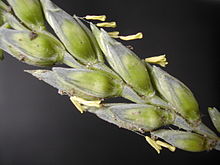 | 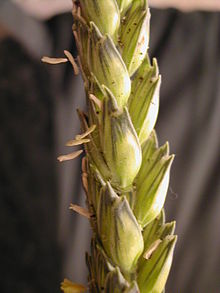 | |
| Wheat at the anthesis stage. Face view (left) and side view (right) | ||
Diseases
Main articles: Wheat diseases and List of wheat diseases
There are many wheat diseases, mainly caused by fungi, bacteria, and viruses.[55] Plant breeding to develop new disease-resistant varieties, and sound crop management practices are important for preventing disease. Fungicides, used to prevent the significant crop losses from fungal disease, can be a significant variable cost in wheat production. Estimates of the amount of wheat production lost owing to plant diseases vary between 10–25% in Missouri.[56] A wide range of organisms infect wheat, of which the most important are viruses and fungi.The main wheat-disease categories are:
- Seed-borne diseases: these include seed-borne scab, seed-borne Stagonospora (previously known as Septoria), common bunt (stinking smut), and loose smut. These are managed with fungicides.
- Leaf- and head- blight diseases: Powdery mildew, leaf rust, Septoria tritici leaf blotch, Stagonospora (Septoria) nodorum leaf and glume blotch, and Fusarium head scab.
- Crown and root rot diseases: Two of the more important of these are 'take-all' and Cephalosporium stripe. Both of these diseases are soil borne.
- Viral diseases: Wheat spindle streak mosaic (yellow mosaic) and barley yellow dwarf are the two most common viral diseases. Control can be achieved by using resistant varieties.


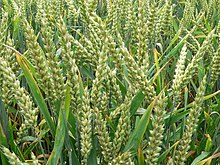

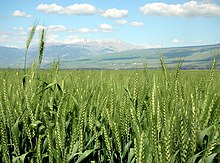
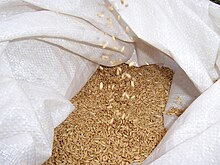
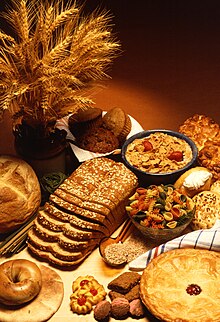


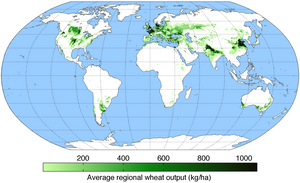

No comments:
Post a Comment